902.3 Traffic Control Signal Needs Studies (MUTCD Chapter 4C)
902.3.1 Studies and Factors for Justifying Traffic Control Signals (MUTCD Section 4C.01)
Standard. An engineering study of traffic conditions, pedestrian characteristics, and physical characteristics of the location shall be performed to determine whether installation of a traffic control signal is justified at a particular location.
The investigation of the need for a traffic control signal shall include an analysis of factors related to the existing operation and safety at the study location and the potential to improve these conditions, and the applicable factors contained in the following traffic signal warrants:
- Warrant 1, Eight-Hour Vehicular Volume
- Warrant 2, Four-Hour Vehicular Volume
- Warrant 3, Peak Hour
- Warrant 4, Pedestrian Volume
- Warrant 5, School Crossing
- Warrant 6, Coordinated Signal System
- Warrant 7, Crash Experience
- Warrant 8, Roadway Network
- Warrant 9, Intersection Near a Grade Crossing
The satisfaction of a traffic signal warrant or warrants shall not in itself require the installation of a traffic control signal.
Support. EPG 902.5.38.2 and EPG 902.5.38.3 contain information regarding the use of traffic control signals instead of gates and/or flashing-light signals at highway-rail grade crossings and highway-light rail transit grade crossings, respectively.
Guidance. A traffic control signal should not be installed unless one or more of the signal warrants in this article are met. Locations meeting the guidelines in this article can be approved at the district level.
A traffic control signal should not be installed unless an engineering study indicates that installing a traffic control signal will improve the overall safety and/or operation of the intersection. The removal of a non-warranted installation is rarely easy to accomplish.
A traffic control signal should not be installed if it will seriously disrupt progressive traffic flow. Traffic signals that are too closely spaced can be a problem to coordinate and may result in a significant loss of operating efficiency. There are three primary areas of concern with close signal spacing:
- 1. Traffic Queuing. Queue spillback between intersections can cause a breakdown in signalized traffic flow. Ideally, signals are to be spaced to allow room for anticipated queues. A rule of thumb for spacing is eight times the largest cycle length used. An estimate of queues can be made using modeling software.
- 2. Signal Coordination. Signal spacing is an important factor in coordination of signals. In general, an analysis of signal coordination is to be done if a new signal will be in a coordinated system, and particularly if the distance from the nearest signal is less than 1000 feet.
3. Operating Efficiency. If the location of the proposed signal shows a potential for queue spillback problems or coordination problems, then the operation will result in a reduced efficiency for both the new signal as well as the adjacent signals. To quantify the reduction in efficiency, an analysis of signal timing and coordination is to be developed that addresses the queuing or coordination problem and compared to existing conditions using modeling software.
Parking on the approaches to the intersection should be reviewed. It may be necessary to restrict parking on one or more approaches in order to increase sight distance or to provide increased capacity at the intersection.
The engineering study should consider the effects of the right-turn vehicles from the minor-street approaches. Engineering judgment should be used to determine what, if any, portion of the right-turn traffic is subtracted from the minor-street traffic count when evaluating the count against the signal warrants listed above. If a separate channelized or "free" right with an adequate approach lane is available or proposed, the benefits of a traffic signal in accomplishing this movement are minimal. In such cases, the right-turning volumes for the affected approaches are not to be included in the warrant evaluation. Where the right turns are under signal control or where there is a free right with no adequate approach lane, right turns may be included in warrant analysis. Right turns are typically allowed on red and right turns only require gaps in one or two conflicting movements. As the right turn percentage of total approach volume increases, the benefit of signalization decreases. To account for this effect in warrant analysis, the percentage of right turns used in warrant analysis is to be reduced as the right turn percentage of total approach volume increases. If right turns on red are prohibited for an approach, the full right-turning volume is to be considered in warrant analysis. The following is a guide for determining the number of right turns to include in a warrant analysis.
Table 902.3.1 Number of Right Turns to Include in a Warrant Analysis
| Proposed Right Turn Condition | Right Turn Percentage (Right Turn Volume/Total Approach Volume) | Percent Right Turn Used in Warrant Analysis |
|---|---|---|
| Free Right With Adequate Lane | Any | 0 |
| Signal Control or Free Right Without Adequate Approach | 0 to 25 | 100 |
| 25 to 50 | 75 | |
| 50 to 75 | 50 | |
| 75 to 100 | 25 | |
| RTOR Restricted | Any | 100 |
Engineering judgment should also be used in applying various traffic signal warrants to cases where approaches consist of one lane plus one left-turn or right-turn lane. The site-specific traffic characteristics should dictate whether an approach is considered as one lane or two lanes. For example, for an approach with one lane for through and right-turning traffic plus a left-turn lane, if engineering judgment indicates that it should be considered a one-lane approach because the traffic using the left-turn lane is minor, the total traffic volume approaching the intersection should be applied against the signal warrants as a one-lane approach. The approach should be considered two lanes if approximately half of the traffic on the approach turns left and the left-turn lane is of sufficient length to accommodate all left-turn vehicles.
Similar engineering judgment and rationale should be applied to a street approach with one through/left-turn lane plus a right-turn lane. In this case, the degree of conflict of minor-street right-turn traffic with traffic on the major street should be considered. Thus, right-turn traffic should not be included in the minor-street volume if the movement enters the major street with minimal conflict. The approach should be evaluated as a one-lane approach with only the traffic volume in the through/left-turn lane considered.
At a location that is under development or construction and where it is not possible to obtain a traffic count that would represent future traffic conditions, hourly volumes should be estimated as part of an engineering study for comparison with traffic signal warrants. Many times developers will submit projected volumes to justify the installation of a traffic signal. Projected volumes, if properly determined, can be accurate gauges of the expected traffic. Great care is to be taken evaluating an intersection for traffic signals when projections are used. The projections are to be part of a formal traffic impact study performed by a traffic engineering consultant. The consultant shall use the principles of the Institute of Transportation Engineers Trip Generation, latest edition when determining the projected volumes at the entrances in question. When projected volumes are used to warrant a traffic signal, the warrants is to be significantly exceeded to provide for reasonable error in the traffic projections used for the development.
Because of increased development along the state highway system by commercial and industrial complexes, along with certain public institutions and street developments, traffic flows are generated which require remedial measures to maintain efficient flow of traffic. Traffic signals can be considered for handling traffic at these developments using Warrant 1 or Warrant 3. To qualify privately owned or publicly owned developments for traffic control measures the applicant must first convey to the Commission, by permanent traffic control easement, that area of operation or area of work which falls on land not within the normal right of way boundaries. The requirements and conditions of the easement will be based on the traffic operational requirements.
A traffic control signal installed under projected conditions should have an engineering study done in the future (ideally within 1 year of putting the signal into stop-and-go operation) to determine if the signal is justified and original study methodology was accurate.
For signal warrant analysis, a location with a wide median, even if the median width is greater than 30 ft., should be considered as one intersection.
Option. At an intersection with a high volume of left-turn traffic from the major street, the signal warrant analysis may be performed in a manner that considers the higher of the major-street left-turn volumes as the “minor-street” volume and the corresponding single direction of opposing traffic on the major street as the “major-street” volume.
For signal warrants requiring conditions to be present for a certain number of hours in order to be satisfied, any four sequential 15-minute periods may be considered as 1 hour if the separate 1-hour periods used in the warrant analysis do not overlap each other and both the major-street volume and the minor-street volume are for the same specific one-hour periods.
For signal warrant analysis, bicyclists may be counted as either vehicles or pedestrians.
Support. When performing a signal warrant analysis, bicyclists riding in the street with other vehicular traffic are usually counted as vehicles and bicyclists who are clearly using pedestrian facilities are usually counted as pedestrians.
Option. Engineering study data may include the following:
- A. The number of vehicles entering the intersection in each hour from each approach during 12 hours of an average day. It is desirable that the hours selected contain the greatest percentage of the 24-hour traffic volume.
- B. Vehicular volumes for each traffic movement from each approach, classified by vehicle type (heavy trucks, passenger cars and light trucks, public-transit vehicles, and, in some locations, bicycles), during each 15-minute period of the 2 hours in the morning and 2 hours in the afternoon during which total traffic entering the intersection is greatest.
- C. Pedestrian volume counts on each crosswalk during the same periods as the vehicular counts in Item B and during hours of highest pedestrian volume. Where young, elderly, and/or persons with physical or visual disabilities need special consideration, the pedestrians and their crossing times may be classified by general observation.
- D. Information about nearby facilities and activity centers that serve the young, elderly, and/or persons with disabilities, including requests from persons with disabilities for accessible crossing improvements at the location under study. These persons might not be adequately reflected in the pedestrian volume count if the absence of a signal restrains their mobility.
- E. The posted or statutory speed limit or the 85th-percentile speed on the uncontrolled approaches to the location.
- F. A condition diagram showing details of the physical layout, including such features as intersection geometrics, channelization, grades, sight-distance restrictions, transit stops and routes, parking conditions, pavement markings, roadway lighting, driveways, nearby railroad crossings, distance to nearest traffic control signals, utility poles and fixtures and adjacent land use.
- G. A collision diagram showing crash experience by type, location, direction of movement, severity, weather, time of day, date, and day of week for at least 1 year.
- H. On-site photographs of all approaches and any special considerations.
The following data, which are desirable for a more precise understanding of the operation of the intersection, may be obtained during the periods described in Item B above:
- A. Delay Study - Vehicle-hours of stopped time delay determined separately for each approach.
- B. Gap Study - The number and distribution of acceptable gaps in vehicular traffic on the major street for entrance from the minor street.
- C. Speed Study - The posted or statutory speed limit or the 85th-percentile speed on controlled approaches at a point near to the intersection but unaffected by the control.
- D. Pedestrian Delay Study - Pedestrian delay time for at least two 30-minute peak pedestrian delay periods of an average weekday or like periods of a Saturday or Sunday.
- E. Queue Study - Queue length on stop-controlled approaches.
- F. Signal Coordination Study - A time-space diagram for the coordinated signal system for each timing plan to be used is developed or revised to include the proposed signal installation. The time-space diagram is based on normal free flow speed for that time of day. It is necessary to develop realistic signal timing and offsets for the new signals. The time-space diagram is reviewed to determine the affects of the new signal on vehicle platooning through the coordinated system. This study can be further enhanced by using a traffic modeling program to help visualize actual conditions.
All of the above counts and data are to be obtained on an average day period.
Adequate roadway capacity is always desirable and especially so at a signalized intersection. The widening of both the main highway and intersecting roadways may be necessary to reduce the delays caused by assignment of right of way at the intersection and the widening itself may reduce or eliminate the need for signalization. In general, it is always desirable to provide a left turn lane for each major approach at each intersection. This is especially so on a two-lane roadway where there are sizable volumes of left-turning traffic. The left turn lane provides a place to separately store left-turning traffic. Separating the through and turning vehicles will generally improve the capacity of the intersection as well as reducing the overall delay at the intersection and the opportunity for rear-end crashes.
902.3.2 Documentation of Warrants
Guidance. Documentation of information pertaining to signal warrants should be completed and approved by district traffic. The district will be responsible for approving the warrants.
Option. Documentation of signal warrant information may include, but is not limited to:
1. Form D-22. Justification of traffic signals may be developed on Form D-22 . Form D-22 is required on all new signal locations and existing signals being upgraded from temporary to permanent signals or where significant geometric or signal revisions are being made. It is not necessary to complete all eleven warrants on the form (e.g. if Warrant 1, Eight-Hour Vehicular Volume, is satisfied, Warrant 3, Peak Hour, does not have to be filled out).
2. Traffic Counts. Traffic counts should must be completed and documented with the warrant analysis.
3. Location sketch. A location sketch or title sheet showing the location of the intersection and any available drawings showing the existing or proposed intersection layout may be included with the warrants.
902.3.3 Warrant 1, Eight-Hour Vehicular Volume (MUTCD Section 4C.02)
Support. The Minimum Vehicular Volume, Condition A, is intended for application at locations where a large volume of intersecting traffic is the principal reason to consider installing a traffic control signal.
The Interruption of Continuous Traffic, Condition B, is intended for application at locations where Condition A is not satisfied and where the traffic volume on a major street is so heavy that traffic on a minor intersecting street suffers excessive delay or conflict in entering or crossing the major street.
It is intended that Warrant 1 be treated as a single warrant. If Condition A is satisfied, then Warrant 1 is satisfied and analyses of Condition B and the combination of Conditions A and B are not needed. Similarly, if Condition B is satisfied, then Warrant 1 is satisfied and an analysis of the combination of Conditions A and B is not needed.
Standard. The need for a traffic control signal shall be considered if an engineering study finds that one of the following conditions exist for each of any 8 hours of an average day:
- A. The vehicles per hour given in both of the 100 percent columns of Condition A in Table 902.3.3 exist on the major-street and the higher-volume minor-street approaches, respectively, to the intersection; or
- B. The vehicles per hour given in both of the 100 percent columns of Condition B in Table 902.3.3 exist on the major-street and the higher-volume minor-street approaches, respectively, to the intersection.
In applying each condition the major-street and minor-street volumes shall be for the same 8 hours. On the minor street, the higher volume shall not be required to be on the same approach during each of these 8 hours (the volumes used for the minor street might be on one approach during some hours and on the opposite approach during other hours).
Option. If the posted or statutory speed limit or the 85th-percentile speed on the major street exceeds 40 mph, or if the intersection lies within the built-up area of an isolated community having a population of less than 10,000, the traffic volumes in the 70 percent columns in Table 902.3.3 may be used in place of the 100 percent columns.
Guidance. The combination of Conditions A and B is intended for application at locations where Condition A is not satisfied and Condition B is not satisfied and should be applied only after an adequate trial of other alternatives that could cause less delay and inconvenience to traffic has failed to solve the traffic problems.
Standard. The need for a traffic control signal shall be considered if an engineering study finds that both of the following conditions exist for each of any 8 hours of an average day:
- A. The vehicles per hour given in both of the 80 percent columns of Condition A in Table 902.3.3 exist on the major-street and the higher-volume minor-street approaches, respectively, to the intersection; and
- B. The vehicles per hour given in both of the 80 percent columns of Condition B in Table 902.3.3 exist on the major-street and the higher-volume minor-street approaches, respectively, to the intersection.
These major-street and minor-street volumes shall be for the same 8 hours for each condition; however, the 8 hours satisfied in Condition A shall not be required to be the same 8 hours satisfied in Condition B. On the minor street, the higher volume shall not be required to be on the same approach during each of the 8 hours.
Option. If the posted or statutory speed limit or the 85th-percentile speed on the major street exceeds 40 mph, or if the intersection lies within the built-up area of an isolated community having a population of less than 10,000, the traffic volumes in the 56 percent columns in Table 902.3.3 may be used in place of the 80 percent columns.
Table 902.3.3 Warrant 1, Eight-Hour Vehicular Volume
| Condition A — Minimum Vehicular Volume | |||||||||
|---|---|---|---|---|---|---|---|---|---|
| Number of lanes for moving traffic on each approach | Vehicles per hour on major street (total of both approaches) | Vehicles per hour on higher-volume
minor-street approach (one direction only) | |||||||
| Major Street | Minor Street | 100% a | 80% b | 70% c | 56% d | 100% a | 80% b | 70% c | 56% d |
| 1 | 1 | 500 | 400 | 350 | 280 | 150 | 120 | 105 | 84 |
| 2 or more | 1 | 600 | 480 | 420 | 336 | 150 | 120 | 105 | 84 |
| 2 or more | 2 or more | 600 | 480 | 420 | 336 | 200 | 160 | 140 | 112 |
| 1 | 2 or more | 500 | 400 | 350 | 280 | 200 | 160 | 140 | 112 |
| Condition B — Interruption of Continuous Traffic | |||||||||
| Number of lanes for moving traffic on each approach | Vehicles per hour on major street (total of both approaches) | Vehicles per hour on higher-volume
minor-street approach (one direction only) | |||||||
| Major Street | Minor Street | 100% a | 80% b | 70% c | 56% d | 100% a | 80% b | 70% c | 56% d |
| 1 | 1 | 750 | 600 | 525 | 420 | 75 | 60 | 53 | 42 |
| 2 or more | 1 | 900 | 720 | 630 | 504 | 75 | 60 | 53 | 42 |
| 2 or more | 2 or more | 900 | 720 | 630 | 504 | 100 | 80 | 70 | 56 |
| 1 | 2 or more | 750 | 600 | 525 | 420 | 100 | 80 | 70 | 56 |
| a Basic minimum hourly volume | |||||||||
| b Used for combination of Conditions A and B after adequate trial of other remedial measures | |||||||||
| c May be used when the major-street speed exceeds 40 mph or in an isolated community with a population of less than 10,000 | |||||||||
| d May be used for combination of Conditions A and B after adequate trial of other remedial measures when the major-street speed exceeds 40 mph or in an isolated community with a population of less than 10,000 | |||||||||
902.3.4 Warrant 2, Four-Hour Vehicular Volume (MUTCD Section 4C.03)
Support. The Four-Hour Vehicular Volume signal warrant conditions are intended to be applied where the volume of intersecting traffic is the principal reason to consider installing a traffic control signal. This warrant is based on existing traffic and is not normally used during project development.
Standard. The need for a traffic control signal shall be considered if an engineering study finds that, for each of any 4 hours of an average day, the plotted points representing the vehicles per hour on the major street (total of both approaches) and the corresponding vehicles per hour on the higher-volume minor-street approach (one direction only) all fall above the applicable curve in Fig. 902.3.4.1 for the existing combination of approach lanes. On the minor street, the higher volume shall not be required to be on the same approach during each of these 4 hours.

Option. If the posted or statutory speed limit or the 85th-percentile speed on the major street exceeds 40 mph, or if the intersection lies within the built-up area of an isolated community having a population of less than 10,000, Fig. 902.3.4.2 may be used in place of Fig. 902.3.4.1.
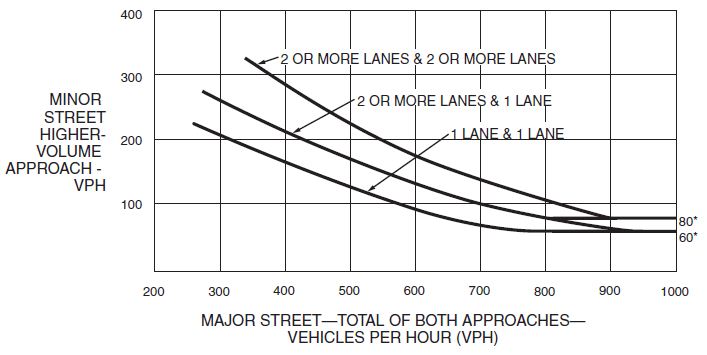
902.3.5 Warrant 3, Peak Hour (MUTCD Section 4C.04)
Support. The Peak Hour signal warrant is intended for use at a location where traffic conditions are such that for a minimum of 1 hour of an average day, the minor-street traffic suffers undue delay when entering or crossing the major street. The need for a traffic signal may exist for peak hours of traffic demand. In order to evaluate a heavy peak hour location, a warrant has been adopted for public streets, industrial or plant entrances, and public institutions.
Standard. This signal warrant shall be applied only in unusual cases, such as office complexes, manufacturing plants, industrial complexes, or high-occupancy vehicle facilities that attract or discharge large numbers of vehicles over a short time.
The need for a traffic control signal shall be considered if an engineering study finds that the criteria in either of the following two categories are met:
- A. If all three of the following conditions exist for the same 1 hour (any four consecutive 15-minute periods) of an average day:
- 1. The total stopped time delay experienced by the traffic on one minor-street approach (one direction only) controlled by a STOP sign equals or exceeds: 4 vehicle-hours for a one-lane approach or 5 vehicle-hours for a two-lane approach; and
- 2. The volume on the same minor-street approach (one direction only) equals or exceeds 100 vehicles per hour for one moving lane of traffic or 150 vehicles per hour for two moving lanes; and
- 3. The total entering volume serviced during the hour equals or exceeds 650 vehicles per hour for intersections with three approaches or 800 vehicles per hour for intersections with four or more approaches.
- B. The plotted point representing the vehicles per hour on the major street (total of both approaches) and the corresponding vehicles per hour on the higher-volume minor-street approach (one direction only) for 1 hour (any four consecutive 15-minute periods) of an average day falls above the applicable curve in Fig. 902.3.5.1 for the existing combination of approach lanes.
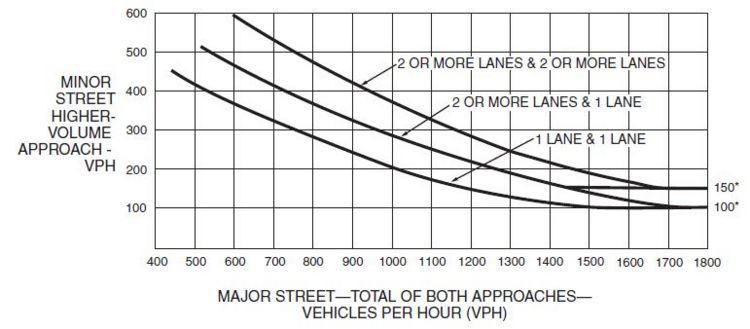
Option. If the posted or statutory speed limit or the 85th-percentile speed on the major street exceeds 40 mph, or if the intersection lies within the built-up area of an isolated community having a population of less than 10,000, Fig. 902.3.5.2 may be used in place of Fig. 902.3.5.1 to evaluate the criteria in the second category of the Standard. If this warrant is the only warrant met and a traffic control signal is justified by an engineering study, the traffic control signal may be operated in the flashing mode.
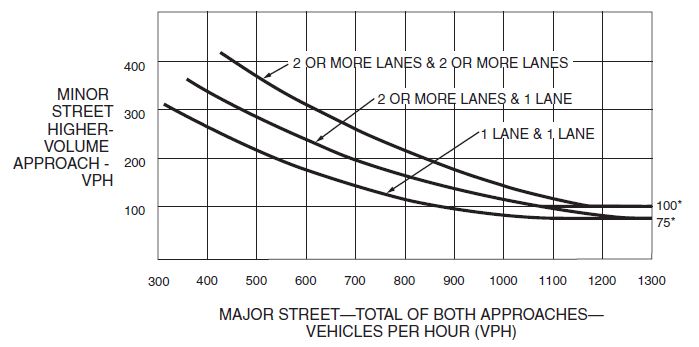
Guidance. Traffic signals installed under these warrants should operate only during those times when 50 percent or more of the warranting volume is present. At all other times, the signals are to be in the flashing mode. This flash operation will be yellow for the state highway and red for the entrance as per EPG 902.5.44.
Guidance. If this warrant is the only warrant met and a traffic control signal is justified by an engineering study, the traffic control signal should be traffic-actuated.
902.3.6 Warrant 4, Pedestrian Volume (MUTCD Section 4C.05)
Support. The Pedestrian Volume signal warrant is intended for application where the traffic volume on a major street is so heavy that pedestrians experience excessive delay in crossing the major street.
Standard. The need for a traffic control signal at an intersection or midblock crossing shall be considered if an engineering study finds that one of the following criteria is met:
- A. For each of any 4 hours of an average day, the plotted points representing the vehicles per hour on the major street (total of both approaches) and the corresponding pedestrians per hour crossing the major street (total of all crossings) all fall above the curve in Fig. 902.3.6.1; or
- B. For 1 hour (any four consecutive 15-minute periods) of an average day, the plotted point representing the vehicles per hour on the major street (total of both approaches) and the corresponding pedestrians per hour crossing the major street (total of all crossings) falls above the curve in Figure 902.3.6.3.
Option. If the posted or statutory speed limit or the 85th-percentile speed on the major street exceeds 35 mph, or if the intersection lies within the built-up area of an isolated community having a population of less than 10,000, Fig. 902.3.6.2 may be used in place of Fig. 902.3.6.1 to evaluate Criterion A above, and Fig. 902.3.6.4 may be used in place of Fig. 902.3.6.3 to evaluate Criterion B above.
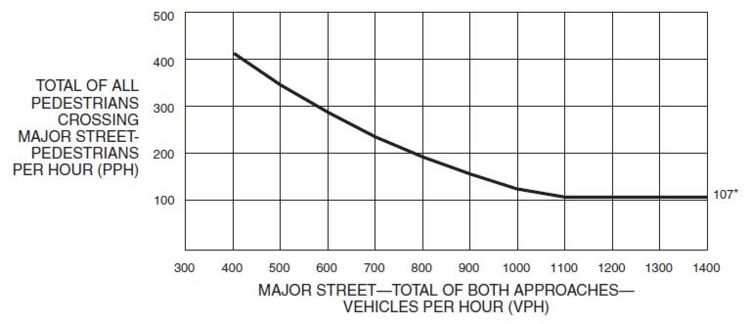
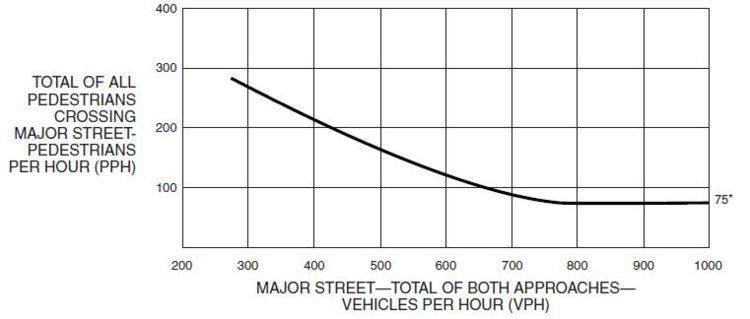
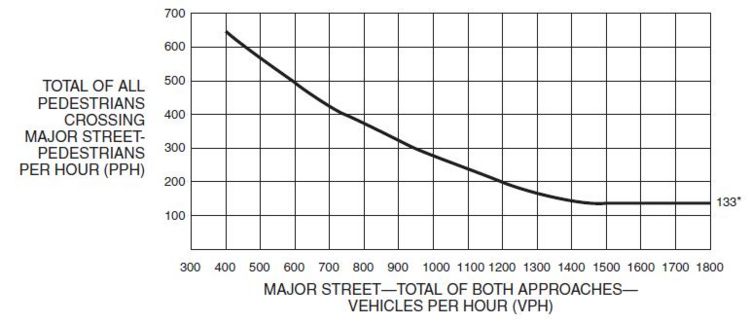
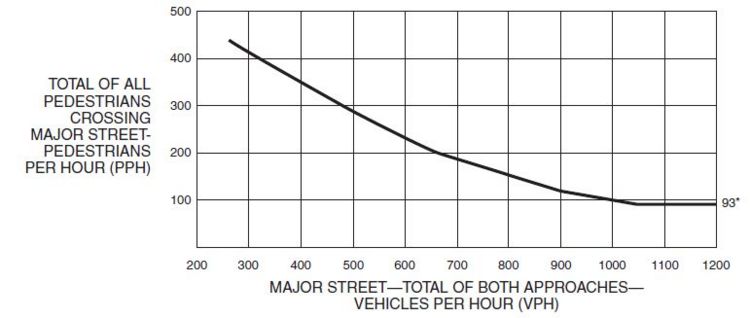
Standard. The Pedestrian Volume signal warrant shall not be applied at locations where the distance to the nearest traffic control signal or STOP sign controlling the street that pedestrians desire to cross is less than 1000 ft., unless the proposed traffic control signal will not restrict the progressive movement of traffic.
If this warrant is met and a traffic control signal is justified by an engineering study, the traffic control signal shall be equipped with pedestrian signal heads complying with the provisions set forth in EPG 902.6 Pedestrian Control Features.
Guidance. If this warrant is met and a traffic control signal is justified by an engineering study, then:
- A. If it is installed at an intersection or major driveway location, the traffic control signal should also control the minor-street or driveway traffic, should be traffic-actuated, and should include pedestrian detection.
- B. If it is installed at a non-intersection crossing, the traffic control signal should be installed at least 100 ft. from side streets or driveways that are controlled by STOP or YIELD signs, and should be pedestrian-actuated. If the traffic control signal is installed at a non-intersection crossing, at least one of the signal faces should be over the traveled way for each approach, parking and other sight obstructions should be prohibited for at least 100 ft. in advance of and at least 20 ft. beyond the crosswalk or site accommodations should be made through curb extensions or other techniques to provide adequate sight distance, and the installation should include suitable standard signs and pavement markings.
- C. Furthermore, if it is installed within a signal system, the traffic control signal should be coordinated.
Option. The criterion for the pedestrian volume crossing the major street may be reduced as much as 50 percent if the 15th-percentile crossing speed of pedestrians is less than 3.5 ft. per second.
A traffic control signal may not be needed at the study location if adjacent coordinated traffic control signals consistently provide gaps of adequate length for pedestrians to cross the street.
902.3.7 Warrant 5, School Crossing (MUTCD Section 4C.06)
Support. The School Crossing signal warrant is intended for application where the fact that schoolchildren cross the major street is the principal reason to consider installing a traffic control signal. For the purposes of this warrant, the word “schoolchildren” includes elementary through high school students.
Standard. The need for a traffic control signal shall be considered when an engineering study of the frequency and adequacy of gaps in the vehicular traffic stream as related to the number and size of groups of schoolchildren at an established school crossing across the major street shows that the number of adequate gaps in the traffic stream during the period when the schoolchildren are using the crossing is less than the number of minutes in the same period (see MUTCD Section 7A.03) and there are a minimum of 20 schoolchildren during the highest crossing hour.
Before a decision is made to install a traffic control signal, consideration shall be given to the implementation of other remedial measures, such as warning signs and flashers, school speed zones, school crossing guards, or a grade-separated crossing.
The School Crossing signal warrant shall not be applied at locations where the distance to the nearest traffic control signal along the major street is less than 1000 ft., unless the proposed traffic control signal will not restrict the progressive movement of traffic.
A contract for adult operation and supervision must be executed with school authorities.
Guidance. If this warrant is met and a traffic control signal is justified by an engineering study, then:
- A. If it is installed at an intersection or major driveway location, the traffic control signal should also control the minor-street or driveway traffic, should be traffic-actuated, and should include pedestrian detection.
- B. If it is installed at a non-intersection crossing, the traffic control signal should be installed at least 100 ft. from side streets or driveways that are controlled by STOP or YIELD signs, and should be pedestrian-actuated. If the traffic control signal is installed at a non-intersection crossing, at least one of the signal faces should be over the traveled way for each approach, parking and other sight obstructions should be prohibited for at least 100 ft. in advance of and at least 20 ft. beyond the crosswalk or site accommodations should be made through curb extensions or other techniques to provide adequate sight distance, and the installation should include suitable standard signs and pavement markings.
- C. Furthermore, if it is installed within a signal system, the traffic control signal should be coordinated.
For further information, see EPG 902.11 Traffic Control for Schools.
902.3.8 Warrant 6, Coordinated Signal System (MUTCD Section 4C.07)
Support. Progressive movement in a coordinated signal system sometimes necessitates installing traffic control signals at intersections where they would not otherwise be needed in order to maintain proper platooning of vehicles. This warrant is based on the premise that vehicular traffic has a tendency to disperse and increase headways between signalized intersections.
Standard. The need for a traffic control signal shall be considered if an engineering study finds that one of the following criteria is met:
- A. On a one-way street or a street that has traffic predominantly in one direction, the adjacent traffic control signals are so far apart that they do not provide the necessary degree of vehicular platooning.
- B. On a two-way street, adjacent traffic control signals do not provide the necessary degree of platooning and the proposed and adjacent traffic control signals will collectively provide a progressive operation.
Guidance. The Coordinated Signal System signal warrant should not be applied where the resultant spacing of traffic control signals would be less than 1,000 feet.
902.3.9 Warrant 7, Crash Experience (MUTCD Section 4C.08)
Support. This warrant is based on crash experience at an intersection. The Crash Experience signal warrant conditions are intended for application where the severity and frequency of crashes are the principal reasons to consider installing a traffic control signal. Crash records and supporting data must be submitted on this warrant.
Standard. The need for a traffic control signal shall be considered if an engineering study finds that all of the following criteria are met:
- A. Adequate trial of alternatives with satisfactory observance and enforcement has failed to reduce the crash frequency; and
- B. Five or more reported crashes, of types susceptible to correction by a traffic control signal, have occurred within a 12-month period, each crash involving personal injury or property damage apparently exceeding the applicable requirements for a reportable crash; and
- C. For each of any 8 hours of an average day, the vehicles per hour (vph) given in both of the 80 percent columns of Condition A in Table 902.3.3 (see EPG 902.3.3), or the vph in both of the 80 percent columns of Condition B in Table 902.3.3 exists on the major-street and the higher-volume minor-street approach, respectively, to the intersection, or the volume of pedestrian traffic is not less than 80 percent of the requirements specified in the Pedestrian Volume warrant. These major-street and minor-street volumes shall be for the same 8 hours. On the minor street, the higher volume shall not be required to be on the same approach during each of the 8 hours.
Option. If the posted or statutory speed limit or the 85th-percentile speed on the major street exceeds 40 mph, or if the intersection lies within the built-up area of an isolated community having a population of less than 10,000, the traffic volumes in the 56 percent columns in Table 902.3.3 may be used in place of the 80 percent columns.
902.3.10 Warrant 8, Roadway Network (MUTCD Section 4C.09)
Support. Installing a traffic control signal at some intersections might be justified to encourage concentration and organization of traffic flow on a roadway network. This warrant is based on existing traffic and is not normally used during project development.
Standard. The need for a traffic control signal shall be considered if an engineering study finds that the common intersection of two or more major routes meets one or both of the following criteria:
- A. The intersection has a total existing, or immediately projected, entering volume of at least 1,000 vehicles per hour during the peak hour of a typical weekday and has 5-year projected traffic volumes, based on an engineering study, that meet one or more of Warrants 1, 2 and 3 during an average weekday; or
- B. The intersection has a total existing or immediately projected entering volume of at least 1,000 vehicles per hour for each of any 5 hours of a non-normal business day (Saturday or Sunday).
A major route as used in this signal warrant shall have at least one of the following characteristics:
- A. It is part of the street or highway system that serves as the principal roadway network for through traffic flow.
- B. It includes rural or suburban highways outside, entering, or traversing a city.
- C. It appears as a major route on an official plan, such as a major street plan in an urban area traffic and transportation study.
902.3.11 Warrant 9, Intersection Near a Grade Crossing (MUTCD Section 4C.10)
Support. The Intersection Near a Grade Crossing signal warrant is intended for use at a location where none of the conditions described in the other eight traffic signal warrants are met, but the proximity to the intersection of a grade crossing on an intersection approach controlled by a STOP or YIELD sign is the principal reason to consider installing a traffic control signal.
Standard. This signal warrant shall be applied only after adequate consideration has been given to other alternatives or after a trial of an alternative has failed to alleviate the safety concerns associated with the grade crossing. Among the alternatives that shall be considered or tried are:
- A. Providing additional pavement that would enable vehicles to clear the track or that would provide space for an evasive maneuver, or
- B. Reassigning the stop controls at the intersection to make the approach across the track a non-stopping approach.
The need for a traffic control signal at an active grade crossing shall be considered if an engineering study finds that both of the following criteria are met:
- A. A grade crossing exists on an approach controlled by a STOP or YIELD sign and the center of the track nearest to the intersection is within 140 ft. of the stop line or yield line on the approach; and
- B. During the highest traffic volume hour during which rail traffic uses the crossing, the plotted point representing the vehicles per hour on the major street (total of both approaches) and the corresponding vehicles per hour on the minor-street approach that crosses the track (one direction only, approaching the intersection) falls above the applicable curve in Fig. 902.3.11.1 or Fig. 902.3.11.2 for the existing combination of approach lanes over the track and the distance D, which is the clear storage distance as defined in EPG 900.1.13 Definitions of Headings, Words and Phrases in the EPG 900 articles.

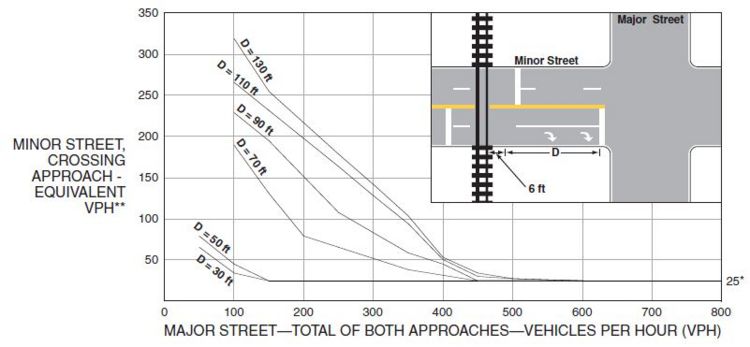
Prior to the installation of a traffic control signal at an active grade crossing, the State Traffic Engineer shall be contacted for final approval of installation.
Guidance. The following considerations apply when plotting the traffic volume data on Fig. 902.3.11.1 or 902.3.11.2:
- A. Fig. 902.3.11.1 should be used if there is only one lane approaching the intersection at the track crossing location and Fig. 902.3.11.2 should be used if there are two or more lanes approaching the intersection at the track crossing location.
- B. After determining the actual distance D, the curve for the distance D that is nearest to the actual distance D should be used. For example, if the actual distance D is 95 ft., the plotted point should be compared to the curve for D = 90 feet.
- C. If the rail traffic arrival times are unknown, the highest traffic volume hour of the day should be used.
Option. The minor-street approach volume may be multiplied by up to three adjustment factors as provided below.
Because the curves are based on an average of four occurrences of rail traffic per day, the vehicles per hour on the minor-street approach may be multiplied by the adjustment factor shown in Table 902.3.11.1 for the appropriate number of occurrences of rail traffic per day.
Because the curves are based on typical vehicle occupancy, if at least 2% of the vehicles crossing the track are buses carrying at least 20 people, the vehicles per hour on the minor-street approach may be multiplied by the adjustment factor shown in Table 902.3.11.2 for the appropriate percentage of high-occupancy buses.
Because the curves are based on tractor-trailer trucks comprising 10% of the vehicles crossing the track, the vehicles per hour on the minor-street approach may be multiplied by the adjustment factor shown in Table 902.3.11.3 for the appropriate distance and percentage of tractor-trailer trucks.
Standard. If this warrant is met and a traffic control signal at the intersection is justified by an engineering study, then:
- A. The traffic control signal shall have actuation on the minor street;
- B. Preemption control shall be provided in accordance with EPG 902.5.38 Preemption and Priority Control of Traffic Control Signals; and
- C. The grade crossing shall have flashing-light signals (see MUTCD Chapter 8C).
Guidance. If this warrant is met and a traffic control signal at the intersection is justified by an engineering study, the grade crossing should have automatic gates (see MUTCD Chapter 8C).
Table 902.3.11.1 Warrant 9, Adjustment Factor for Daily Frequency of Rail Traffic
| Rail Traffic per Day | Adjustment Factor |
|---|---|
| 1 | 0.67 |
| 2 | 0.91 |
| 3 to 5 | 1.00 |
| 6 to 8 | 1.18 |
| 9 to 11 | 1.25 |
| 12 or more | 1.33 |
Table 902.3.11.2 Warrant 9, Adjustment Factor for Percentage of High-Occupancy Buses
| % of High-Occupancy Buses* on Minor-Street Approach | Adjustment Factor |
|---|---|
| 0 | 1.00 |
| 2 | 1.09 |
| 4 | 1.19 |
| 6 or more | 1.32 |
| * A high-occupancy bus is defined as a bus occupied by at least 20 people. | |
Table 902.3.11.3 Warrant 9, Adjustment Factor for Percentage of Tractor-Trailer Trucks
| % of Tractor-Trailer Trucks on Minor-Street Approach | Adjustment Factor | |
|---|---|---|
| D less than 70 ft. | D of 70 ft. or more | |
| 0% to 2.5% | 0.50 | 0.50 |
| 2.6% to 7.5% | 0.75 | 0.75 |
| 7.6% to 12.5% | 1.00 | 1.00 |
| 12.6% to 17.5% | 2.30 | 1.15 |
| 17.6% to 22.5% | 2.70 | 1.35 |
| 22.6% to 27.5% | 3.28 | 1.64 |
| More than 27.5% | 4.18 | 2.09 |